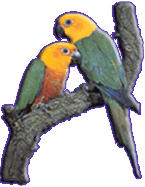In the wild, this species inhabit lands of Sri Lanka , India , Pakistan and Nepal , that means we are talking about Asian parrot species. Plum-headed parakeet nests in tall tree woods, mostly in hollows, rarely near ground. They fed on various kinds of seeds that can be found in the wild, and they are very fond of fruits and vegetables. These birds are very friendly, and live in smaller flocks. Plum-headed parakeets are the smallest ones from Psitaccula genus. It reaches size of 33 to 35 cm and has a very long beautiful tail, that makes them fast and good flyer. The basic color of male is green, and violet black ring separate colorings of red head and body. Backs are a bit darker green than the chests. Wing feathers are a combination of green shades with reddish-brown spot on each side of the shoulders. The tail is blue on the outer side while the very end of it is yellowish-white. The female has almost the same body colorings, but lacks the reddish-brown spots. Her head is grey-blue and has yellow ring around her neck. These color differences are at the same time the biggest difference between sexes. Young birds resemble the female, there are no differences between youngsters until they assume their adult coloration at 2 years of age. One thing is specific for Plum-headed parakeets and that is relation between males and females in the wild. There is 80 % of males, and only 20 % of females, which should be controlled so that in the future this species do not extinguish.
Beside basic color, genetically are made yellow, blue and red mutations, which, for now, can only be seen in the voliers, as there are no such mutations in the nature.
As many parrot species, acclimatization of Plum-headed parakeet is quick, and it is easy to breed them, in our country as well as all over Europe and around the world. If kept singly as a pet, no matter the sex, it will soon get tamed and learn to imitate words. It can learn about two hundred words. To achieve this word fond the bird must be young and needs a lot of patient. The life span of Plum-headed parakeet is around 30 years
Female lays 4 to 6 eggs. Incubation period lasts for 22 to 23 days. Six weeks after hatching from the eggs, young birds leave the nest for the first time. The male feeds the youngsters for 4 to 5 more weeks, after which they start their own separate lives.
Adults are fed on seeds of sunflower, setaria, bright seed, sorghum, hemp. Beside seedish food, they should get apples, carrots, spinach, sweet paprika seed, cucumber, and off course complex of vitamins and minerals. Every spring, for prevention they should be given water with addition of some antibiotics based on oxytetracycline. During the year, their water should be supplemented with potassium permanganate for a few days, because this solution cleans up their crop. Another preventive action is also advised and considers giving anti intestine-parasites medicine, during few days, once a year. It is for the best to consult the breeder for the specifics of these medicines as well as the dosages.

